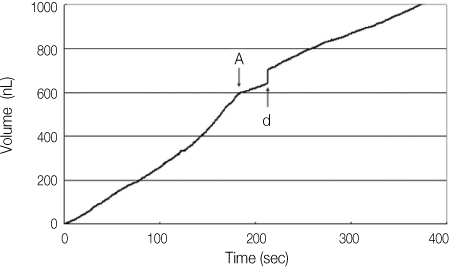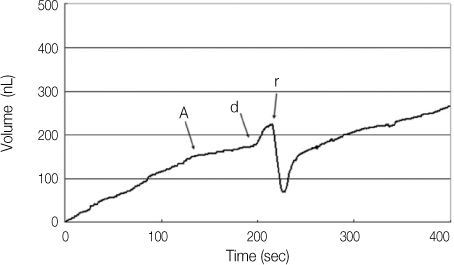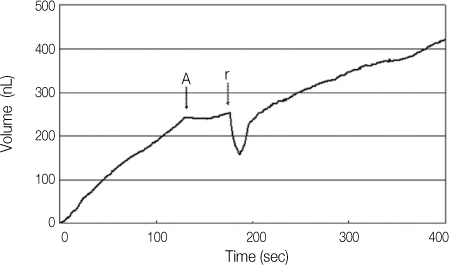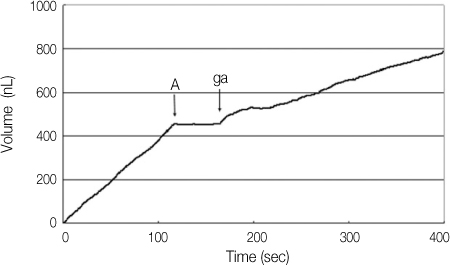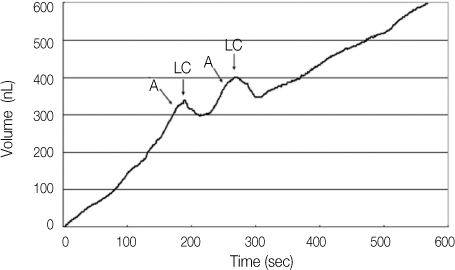J Korean Acad Conserv Dent.
2010 Sep;35(5):313-320. 10.5395/JKACD.2010.35.5.313.
Real-time measurement of dentinal fluid flow during desensitizing agent application
- Affiliations
-
- 1Department of Conservative Dentistry, KyungHee University School of Dentistry, Seoul, Korea.
- 2Department of Dental Hygiene, Dong-Nam Health University, Suwon, Korea.
- 3Department of Conservative Dentistry, Seoul National University School of Dentistry, Seoul, Korea. inboglee@snu.ac.kr
- KMID: 2176429
- DOI: http://doi.org/10.5395/JKACD.2010.35.5.313
Abstract
OBJECTIVES
The aim of this study was to examine changes in the dentinal fluid flow (DFF) during desensitizing agent application and to compare permeability after application among the agents.
MATERIALS AND METHODS
A Class 5 cavity was prepared to exposure cervical dentin on an extracted human premolar which was connected to a sub-nanoliter fluid flow measuring device (NFMD) under 20 cm water pressure. DFF was measured from before application of desensitizing agent (Seal&Protect, SP; SuperSeal, SS; BisBlock, BB; Gluma desensitizer, GL; Bi-Fluoride 12, BF) through application procedure to 5 min after application.
RESULTS
DFF rate after each desensitizing agent application was significantly reduced when compared to initial DFF rate before application (p < 0.05). SP showed a greater reduction in DFF rate than GL and BF did (p < 0.05). SS and BB showed a greater reduction in DFF rate than BF did (p < 0.05).
CONCLUSIONS
Characteristic DFF aspect of each desensitizing agent was shown in NFMD during the application procedure.
Keyword
MeSH Terms
Figure
Reference
-
1. Brännström M, Lindén LA, Aström A. The hydrodynamics of the dental tubule and of pulp fluid. A discussion of its significance in relation to dentinal sensitivity. Caries Res. 1967. 1:310–317.
Article2. Pashley DH. Dentin permeability, dentin sensitivity, and treatment through tubule occlusion. J Endod. 1986. 12:465–474.
Article3. Absi EG, Addy M, Adams D. Dentine hypersensitivity. A study of the patency of dentinal tubules in sensitive and non-sensitive cervical dentine. J Clin Periodontol. 1987. 14:280–284.
Article4. Pashley DH. Addy M, Embrey G, Edgar WM, Orchardson R, editors. Potential treatment modalities for dentine hypersensitivity: in-office products. Tooth wear and sensitivity: clinical advances in restorative dentistry. 2000. London: Martis Dunitz;351–365.5. Vieira AH, Santiago SL. Management of dentinal hypersensitivity. Gen Dent. 2009. 57:120–126.6. Lee IB, Kim MH, Kim SY, Chang J, Cho BH, Son HH, Back SH. Development of nano-fluid movement measuring device and its application to hydrodynamic analysis of dentinal fluid. J Korean Acad Conserv Dent. 2008. 33:141–147.
Article7. Kim SY, Cho BH, Baek SH, Lim BS, Lee IB. Real-time measurement of dentinal tubular fluid flow during and after amalgam and composite restorations. J Korean Acad Conserv Dent. 2009. 34:467–476.
Article8. Ciucchi B, Bouillaguet S, Holz J, Pashley D. Dentinal fluid dynamics in human teeth, in vivo. J Endod. 1995. 21:191–194.
Article9. Pashley DH, Stewart FP, Galloway SE. Effects of air-drying in vitro on human dentine permeability. Arch Oral Biol. 1984. 29:379–383.
Article10. Itthagarun A, Tay FR, Pashley DH, Wefel JS, Garclía-Godoy F, Wei SH. Single-step, self-etch adhesives behave as permeable membranes after polymerization. Part III. Evidence from fluid conductance and artificial caries inhibition. Am J Dent. 2004. 17:394–400.11. Camps J, About I, Van Meerbeek B, Franquin JC. Efficiency and cytotoxicity of resin-based desensitizing agents. Am J Dent. 2002. 15:300–304.12. Pamir T, Dalgar H, Onal B. Clinical evaluation of three desensitizing agents in relieving dentin hypersensitivity. Oper Dent. 2007. 32:544–548.
Article13. Pereira JC, Segala AD, Gillam DG. Effect of desensitizing agents on the hydraulic conductance of human dentin subjected to different surface pre-treatments-an in vitro study. Dent Mater. 2005. 21:129–138.
Article14. Pashley DH, Galloway SE. The effects of oxalate treatment on the smear layer of ground surfaces of human dentine. Arch Oral Biol. 1985. 30:731–737.
Article15. Greenhill JD, Pashley DH. The effects of desensitizing agents on the hydraulic conductance of human dentin in vitro. J Dent Res. 1981. 60:686–698.
Article16. Paes Leme AF, dos Santos JC, Giannini M, Wada RS. Occlusion of dentin tubules by desensitizing agents. Am J Dent. 2004. 17:368–372.17. Thrash WJ, Jones DL, Dodds WJ. Effect of a fluoride solution on dentinal hypersensitivity. Am J Dent. 1992. 5:299–302.18. Yates RJ, Newcombe RG, Addy M. Dentine hypersensitivity: a randomised, double-blind placebo-controlled study of the efficacy of a fluoride-sensitive teeth mouthrinse. J Clin Periodontol. 2004. 31:885–889.
Article19. Qin C, Xu J, Zhang Y. Spectroscopic investigation of the function of aqueous 2-hydroxyethylmethacrylate/glutaraldehyde solution as a dentin desensitizer. Eur J Oral Sci. 2006. 114:354–359.
Article20. Munksgaard EC. Amine-induced polymerization of aqueous HEMA/aldehyde during action as a dentin bonding agent. J Dent Res. 1990. 69:1236–1239.
Article21. Kakaboura A, Rahiotis C, Thomaidis S, Doukoudakis S. Clinical effectiveness of two agents on the treatment of tooth cervical hypersensitivity. Am J Dent. 2005. 18:291–295.22. Ozen T, Orhan K, Avsever H, Tunca YM, Ulker AE, Akyol M. Dentin hypersensitivity: a randomized clinical comparison of three different agents in a short-term treatment period. Oper Dent. 2009. 34:392–398.
Article23. Davidson DF, Suzuki M. The Gluma bonding system: a clinical evaluation of its various components for the treatment of hypersensitive root dentin. J Can Dent Assoc. 1997. 63:38–41.24. Ishihata H, Kanehira M, Nagai T, Finger WJ, Shimauchi H, Komatsu M. Effect of desensitizing agents on dentin permeability. Am J Dent. 2009. 22:143–146.
- Full Text Links
- Actions
-
Cited
- CITED
-
- Close
- Share
- Similar articles
-
- Development of nano-fluid movement measuring device and its application to hydrodynamic analysis of dentinal fluid
- The Effects Of Desensitizing Agents And Tooth Brushing On Dentin Permeability, In Vitro
- The effects of desensitizing agents, bonding resin and tooth brushing on dentin permeability, in vitro
- Real-time measurement of dentinal tubular fluid flow during and after amalgam and composite restorations
- A SEM study of dentinal tubule sealing effect of desensitizing agent applicated after root planning


